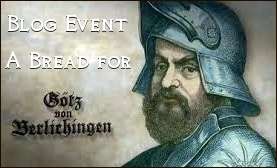Hier geht's zur deutschen Version dieses Posts (folgt noch)
I missed a few ABC baking projects (there was always something else going on), but our "pack leader" Hanaâ's September pick, King Arthur Flour's Almond Tarts featured almonds, and nuts are my favorite baking ingredients.
There was one problem, though - my husband doesn't care for strong almond aroma, and complains every time I use more than a few drops almond extract. And what is an almond tart without almond taste?
 My birthday cake has always been a plum cake, in early September, when they are just ripe. When I first came to Maine, I couldn't find Italian prune plums, the best kind for baking - too tart for raw consumption but delicious when cooked.
My birthday cake has always been a plum cake, in early September, when they are just ripe. When I first came to Maine, I couldn't find Italian prune plums, the best kind for baking - too tart for raw consumption but delicious when cooked.Fortunately that has changed, and now, soon as I see them at our supermarket, I grab a few pounds - it's time for my plum cake. And what could better offset a sweet, almond-y filling than a combination with tart, flavorful plums?
A few other tweaks to the filling: I reduced the sugar by 25%, using a mix of white and brown, and substituted some of the white flour for whole wheat. For my husband's sake, I added only half of the almond extract.
My Almond Plum Cake turned out just as I had hoped - a blissful marriage of tart, juicy plums with marzipan-like sweet almond filling: the BEST PLUM CAKE I EVER HAD!
 |
| De-licious - the best pum cake I ever had |
ALMOND PLUM CAKE (adapted from King Arthur Flour)
CRUST
99 g/3.5 oz sugar (1/2 cup)
113 g/4 oz soft butter (1 stick)
1/4 tsp. salt
1 tsp. vanilla extract
1/2 tsp. almond extract
130 g/4.6 oz all-purpose flour
47 g1.7 oz whole wheat pastry
74 g/2.6 oz almond meal (3/4 cup)
FILLING
57 g/2 oz soft butter (1/2 stick)
1/4 tsp. salt (I used only 1/8 tsp.)
75 g/2.6 oz sugar
75 g/2.6 oz light brown sugar
14 g/2 tbsp. all-purpose flour
1/2 tsp. almond extract
1 tsp. vanilla extract
1/8 tsp. cinnamon
3 eggs
124 g/4.4 oz almond flour (1 1/4 cup)
ca. 600 g/21 oz plums, pitted, and halved
Preheat oven to 350°F.
Beat together sugar, butter, salt, and extracts. Add flours, stirring to make crumbs that cling together when squeezed.
 |
| Using a tamper or a flat bottomed cup measure to press the crumbs into the pan |
Press crumbs into bottom and up the sides of a 9"/23 cm springform pan, and prick crust all over with a fork. Place crust for 15 minutes in the freezer.
Bake crust until it is just beginning to brown on the edges, 22 minutes. Let it cool on a wire rack (don't turn the oven off).
 |
| The almond filling is very easy to make |
FILLING:
Beat together butter, salt, sugar, flour, and extracts. Beat in eggs, then add almond flour, stirring just to combine.
Distribute plum halves over the par-baked crust. Pour filling evenly over the plums.
 |
| The almond filling covers the plums almost completely |
Bake the cake for 40-43 minutes, until the top is lightly browned. Let it cool in the pan on a wire rack.
To serve, remove the ring of the springform pan and transfer the cake to a serving plate. (I usually don't bother to remove it from the bottom of the pan).
 |
| In all its glory: Almond Plum Cake |
NOTE: The almond plum cake keeps very well, even after 3 days at (not very cool) room temperature it tasted still good!
If you would like to join the Avid Bakers and take part in our monthly challenge, click here. New members are always welcome!






